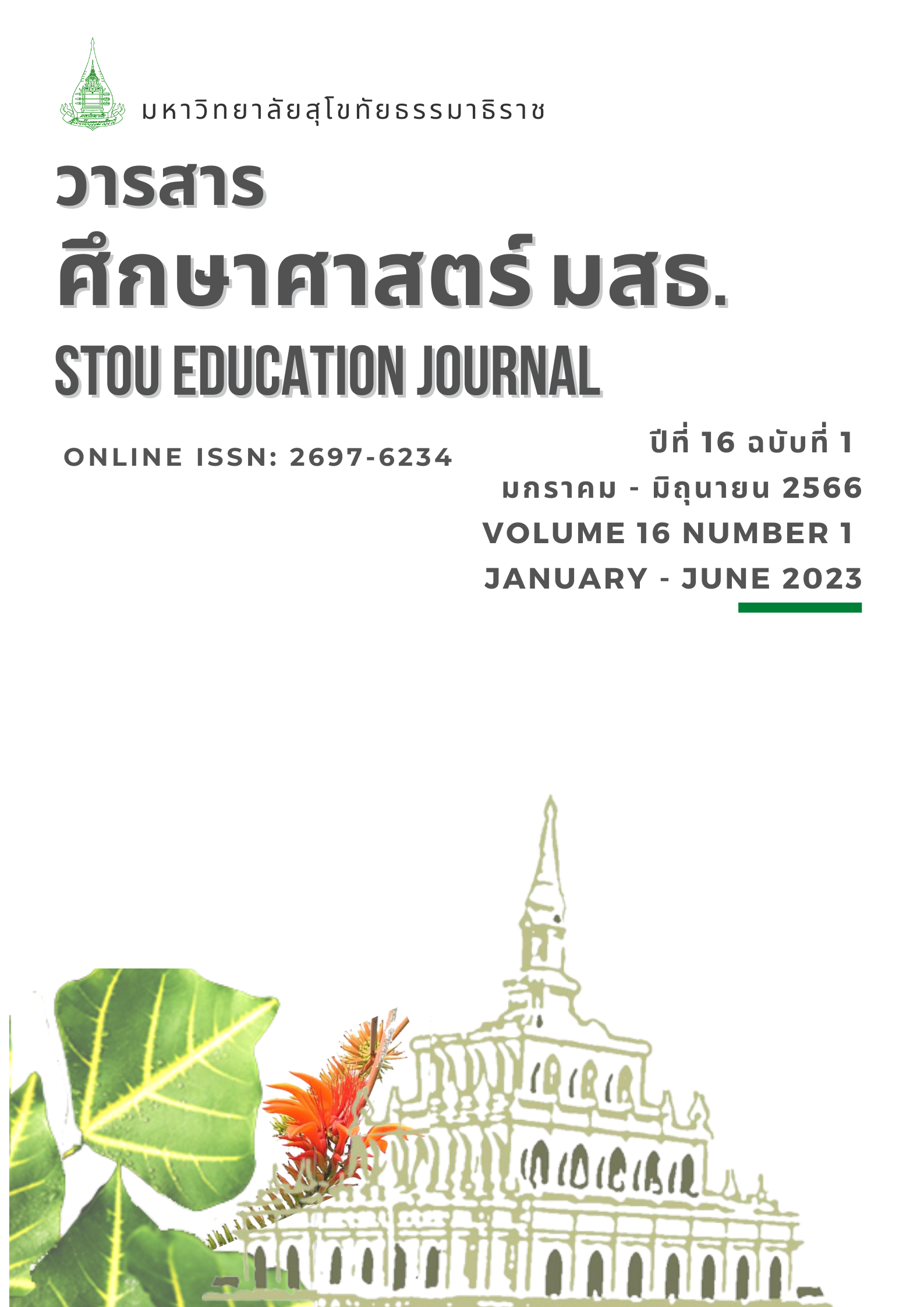Developing Mathematics Problem Solving and Mathematics Communication Ability by Using Open Approach in the Topic of Time for Grade 3 Students at Chumchon Ban Thung School in Lampang Province
Main Article Content
Abstract
The purposes of this research were (1) to develop mathematics problem solving ability in the topic of Time; and (2) to develop mathematical communication ability in the topic of Time of students who engaged in learning activities under the Open Approach. The target group consisted of 26 Grade 3 students of Chumchon Ban Thung School in Lampang Province. The research was conducted in 3 cycles. The research instruments were learning management plans in the topic of Time, the protocol analysis recording forms, the performance assessment forms, the classroom observation forms, a recording form after using learning activities plan, quizzes, a mathematics problem-solving ability test, and a mathematics communication ability test. The data were analyzed using the mean, standard deviation, content analysis, interpretation, and conclusion. The results showed that (1) the mathematics problem solving abilities of students in the whole class were higher immediately after practicing in the second cycle; however, the average scores were greater than 70 percent in all cycles and after the end of the operation (74.23, 81.35, 79.04 and 70.77 respectively); if only normal students were considered, it was found that their average scores were more than 90% in all cycles and more than 80% after the end of the operation (91.32, 90.79 and 90.53, and 86.32 respectively); and (2) the mathematical communication abilities of students in the whole class increased from the fair level to the good and very good levels respectively; in the first cycle, 26.92% of the students had the fair level of mathematical communication abilities, while 73.08% of them had the good level of mathematical communication abilities; in the second cycle, 11.54% of students had the fair level while 88.46% of them had the good level of mathematical communication abilities; in the third cycle, 19.23% of students had the good level while 80.77% of them had the very good level of mathematical communication abilities; and at the end of the operation, 80.77% of students had the good level or higher of mathematical communication abilities.
Article Details
References
จริยา สุนทรหาญ. (2561). ผลการจัดกิจกรรมการเรียนรู้โดยใช้วิธีการแบบเปิดที่มีผลต่อความสามารถในการแก้ปัญหาทางคณิตศาสตร์และการสื่อสารทางคณิตศาสตร์ของนักเรียนชั้นประถมศึกษาปีที่ 4 [วิทยานิพนธ์ปริญญามหาบัณฑิต ไม่ได้ตีพิมพ์]. มหาวิทยาลัยบูรพา.
ชานนท์ รักปรางค์. (2562). ปัจจัยที่ส่งผลต่อความสามารถในการสื่อสารทางคณิตศาสตร์ของนักเรียนชั้นมัธยมศึกษาปีที่ 4. [การศึกษาค้นคว้าอิสระการศึกษามหาบัณฑิต ไม่ได้ตีพิมพ์]. มหาวิทยาลัยสุโขทัยธรรมาธิราช.
พิมพ์สุภา วุ่นเหลี่ยม. (2563). ความสามารถในการแก้ปัญหาและการสื่อสารทางคณิตศาสตร์ เรื่อง สมการเชิงเส้นตัวแปรเดียวของนักเรียนชั้นมัธยมศึกษาปีที่ 1 โดยใช้วิธีการแบบเปิด. [วิทยานิพนธ์ปริญญามหาบัณฑิต ไม่ได้ตีพิมพ์]. มหาวิทยาลัยมหาสารคาม.
ไพศาล แมลงทับทอง. (2564). ผลการจัดกิจกรรมการเรียนรู้คณิตศาสตร์โดยใช้รูปแบบการจัดกิจกรรมการเรียนรู้แบบเปิด (Open Approach) ร่วมกับ Math Model ที่ส่งผลต่อผลสัมฤทธิ์และความสามารถในการสื่อสารด้านการเขียนทางคณิตศาสตร์ของนักเรียนระดับชั้นมัธยมศึกษาปีที่ 6 เรื่อง แคลคูลัส. วารสารการประชุมวิชาการวิทยาศาสตร์คณิตศาสตร์ในโรงเรียน ระดับชาติ ครั้งที่ 24 ในรูปแบบออนไลน์.
ไมตรี อินประสิทธิ์. (2557). กระบวนการแก้ปัญหาในคณิตศาสตร์ระดับโรงเรียน. เพ็ญพรินติ้ง.
รุ่งทิวา แย้มรุ่ง. (2559). หน่วยที่ 7 การจัดประสบการณ์เรียนรู้เกี่ยวกับการวัด ใน ประมวลสาระชุดวิชาการจัดประสบการณ์การเรียนรู้คณิตศาสตร์ หน่วยที่ 1-8 (พิมพ์ครั้งที่ 3, น. 1-80). สาขาวิชาศึกษาศาสตร์ มหาวิทยาลัยสุโขทัยธรรมาธิราช.
วิรัลยุพา คงภักดี. (2561). การศึกษาความสามารถในการแก้ปัญหาทางคณิตศาสตร์ผ่านการจัดกิจกรรมการเรียนรู้โดยใช้วิธีการแบบเปิด. วารสารศึกษาศาสตร์ มสธ. 11(2),86-101.
สถาบันส่งเสริมการสอนวิทยาศาสตร์และเทคโนโลยี. (2558). การศึกษาคณิตศาสตร์ในระดับโรงเรียนไทย: การพัฒนา ผลกระทบ ภาวะถดถอยในปัจจุบัน. สถาบันส่งเสริมการสอนวิทยาศาสตร์และเทคโนโลยี.
สถาบันส่งเสริมการสอนวิทยาศาสตร์และเทคโนโลยี. (2560). คู่มือการใช้หลักสูตรกลุ่มสาระการเรียนรู้คณิตศาสตร์ (ฉบับปรับปรุง พ.ศ. 2560) ตามหลักสูตรแกนกลางการศึกษาขั้นพื้นฐาน พุทธศักราช 2551 ระดับประถมศึกษา. ม.ป.ท.
สัมพันธ์ ถิ่นเวียงทอง. (2561). ความสามารถในการใช้การสื่อสารกลุ่มย่อยทางคณิตศาสตร์และเจตคติต่อการเรียนรู้คณิตศาสตร์ของนักเรียนในชั้นเรียนที่ใช้การศึกษาชั้นเรียนและวิธีการแบบเปิด. โครงการพัฒนาการคิดขั้นสูงทางคณิตศาสตร์ของนักเรียนในเขตพื้นที่ภาคตะวันออกเฉียงเหนือ. มหาวิทยาลัยขอนแก่น.
สำนักงานเลขาธิการสภาการศึกษา. (2560). แผนพัฒนาการศึกษาแห่งชาติ พ.ศ.2560 - 2579. พริกหวานกราฟฟิค.
สำนักทดสอบทางการศึกษา. (2562). รายงานผลการประเมินคุณภาพผู้เรียน (National Test: NT) ชั้นประถมศึกษาปีที่ 3 ปีการศึกษา 2562. โรงเรียนชุมชนบ้านทุ่ง.
สำนักทดสอบทางการศึกษา. (2563). รายงานผลการประเมินคุณภาพผู้เรียน (National Test: NT) ชั้นประถมศึกษาปีที่ 3 ปีการศึกษา 2563. โรงเรียนชุมชนบ้านทุ่ง.
Kemmis, S., & McTaggart, R. (1990). The action research planner (3rd ed.). Deakin University Press.
Kennedy, L. M., & Tipps, K. (1994). Guiding Children’s Learning of Mathematics (7th ed.). Woodworth Publishing.
Nohda, N. (2000). Teaching by Open-Approach Method in Japanese Mathematics Classroom. Proceeding of the 24th Conference of the International Group for the Psychology of Mathematics Education (PME 24) (pp. 39-54). Hiroshima University.
Polya, G. (1945). How to solve it: A new aspect of mathematical method. Doubleday & Company.


